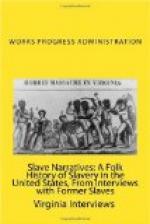“No’em, ah jes cain’t tell you all no cryin sad story ‘bout beatin’ an a slave drivin, an ah don’ know no ghost stories, ner nuthin’—ah is jes dumb dat way—ah’s sorry ’bout it, but ah Jes—is.”
Samuel Sutton lives in north lane Lebanon, just back of the French Creamery. He has one acre of land, a little unpainted, poorly furnished and poorly kept. His daughter is a huge fleshy colored woman wears a turban on her head. She has a fixed smile; says not a word. Samuel talks easily; answers questions directly; is quick in his movements. He is stooped and may 5’7” or 8” if standing straight. He wears an old fashioned “Walrus” mustache, and has a grey wooley fringe of hair about his smooth chocolate colored bald head. He is very dark in color, but his son is darker yet. His hearing is good. His sight very poor. Being so young when the Civil War was over, he remembers little or nothing about what the colored people thought or expected from freedom. He just remembers what a big time there was on that first “Free Fourth of July.”
Ruth Thompson, Interviewing Graff, Editing
Ex-Slave Interviews
Hamilton Co., District 12
Cincinnati
RICHARD TOLER 515 Poplar St., Cincinnati, O.
[Illustration: Richard Toler]
“Ah never fit in de wah; no suh, ah couldn’t. Mah belly’s been broke! But ah sho’ did want to, and ah went up to be examined, but they didn’t receive me on account of mah broken stomach. But ah sho’ tried, ’cause ah wanted to be free. Ah didn’t like to be no slave. Dat wasn’t good times.”
Richard Toler, 515 Poplar Street, century old former slave lifted a bony knee with one gnarled hand and crossed his legs, then smoothed his thick white beard. His rocking chair creaked, the flies droned, and through the open, unscreened door came the bawling of a calf from the building of a hide company across the street. A maltese kitten sauntered into the front room, which served as parlor and bedroom, and climbed complacently into his lap. In one corner a wooden bed was piled high with feather ticks, and bedecked with a crazy quilt and an number of small, brightly-colored pillows; a bureau opposite was laden to the edges with a collection of odds and ends—a one-legged alarm clock, a coal oil lamp, faded aritifical flowers in a gaudy vase, a pile of newspapers. A trunk against the wall was littered with several large books (one of which was the family Bible), a stack of dusty lamp shades, a dingy sweater, and several bushel-basket lids. Several packing cases and crates, a lard can full of cracked ice, a small, round oil heating stove, and an assorted lot of chairs completed the furnishings. The one decorative spot in the room was on the wall over the bed, where hung a large framed picture of Christ in The Temple. The two rooms beyond exhibited various broken-down additions to the heterogeneous collection.




